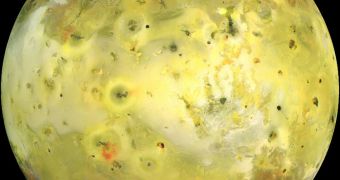Io, one of Jupiter's largest moons, is indeed a unique object in the solar system. In addition to being the most volcanically-active, it is also the only known celestial body that does not have impact craters. A new study demonstrates that the two are connected.
In other words, this moon features no visible scarring from past asteroid and comet impacts simply because its 400+ volcanoes are producing new crust at an exceedingly-fast rate. This ensures that any “wounds” are healed within a few million years.
The conclusion belongs to a new study conducted by experts at the Arizona State University (ASU), who recently completed the first comprehensive global geologic map of the innermost of Jupiter's largest moons. Io was discovered by Galileo, more than 400 years ago.
This map is outstanding because it reveals both the relative age and the characteristics of the most unique and active volcano, lava flows and other geological features. It also sheds more light on the moon's very active volcanic resurfacing.
In addition to the influence that volcanoes have, Io's surface is also severely deformed by the gravitational interactions occurring between itself, Jupiter, and two other moons – Europa and Ganymede. These influences cause its crust to flex considerably.
At the same time, the flexures heat up the moon's interior by a wide margin, which further contributes to its excessive volcanism, Daily Galaxy reports.
“One of the reasons for making this map was to create a tool for continuing scientific studies of Io, and a tool for target planning of Io observations on future missions to the Jupiter system,” explains study researcher David Williams.
He holds an appointment as a faculty research associate in the ASU School of Earth and Space Exploration, and was the leader of the six-year research project that eventually yielded the new geologic map.
Thanks to the dataset, it may now become possible to understand Io's interior in more detail than ever before, researchers say. The work is made significantly more difficult by the fact that no permanent orbiters fly around Jupiter, its rings and its moon system
“Because of the non-uniform coverage of Io by multiple Voyager and Galileo flybys, including a variety of lighting conditions, it was absolutely necessary to use the different mosaics to identify specific geologic features, such as separating mountains and paterae from plains, and separating the colored plume deposits from the underlying geologic units,” Williams concludes.

 14 DAY TRIAL //
14 DAY TRIAL //